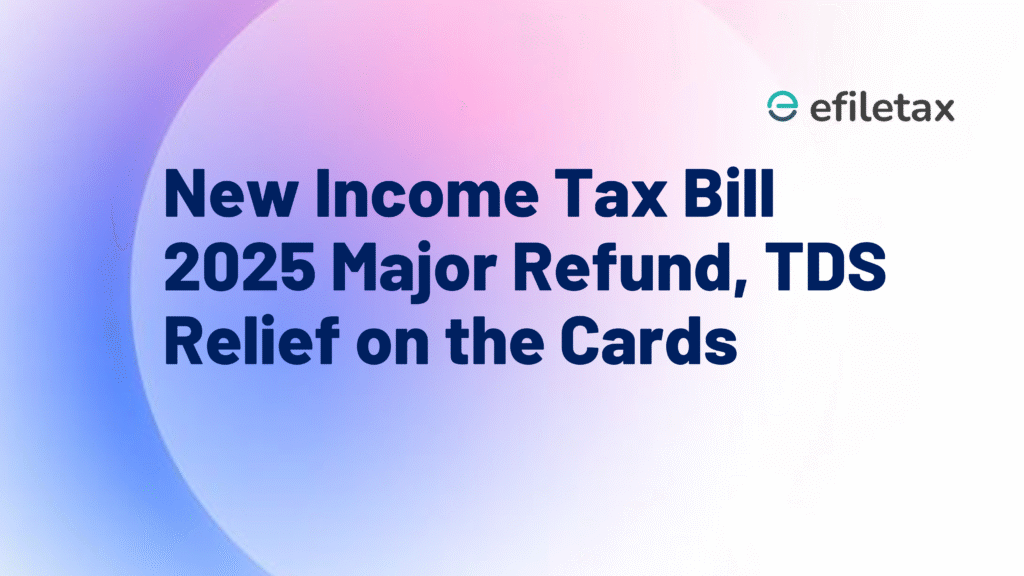
New Income Tax Bill 2025: What It Means for You
The New Income Tax Bill 2025, expected to be enforced from April 1, 2026, aims to replace the complex Income-tax Act, 1961 with a modern, concise, and transparent law. This long-awaited reform is not just a cosmetic overhaul — it rewrites tax rules for India’s digital economy and eases the burden on taxpayers.
Let’s break down what’s changing, what it means for you, and how Efiletax can help you stay ahead.
Why a New Income Tax Law Was Needed
The current Income-tax Act, 1961 has:
- Over 4,000 amendments since inception
- More than 2.6 lakh words, making it one of the most verbose tax codes globally
- Dozens of overlapping provisions leading to confusion, litigation, and frequent notices
To address this, the Central Board of Direct Taxes (CBDT) initiated a consultative process in early 2025, resulting in a draft direct tax code based on recommendations by a Lok Sabha select committee.
Major Highlights of New Income Tax Bill 2025
Simpler Structure with 536 Sections
The new bill trims the tax code down to 536 sections — focusing on clarity, accessibility, and plain language.
Refunds for Late ITR Filers
One of the most surprising reforms:
- Late filers may still get refunds, subject to certain limits.
- This overturns the current stance under Section 139(4) where belated returns were often disqualified from refunds.
This change, if passed, could offer relief to lakhs of taxpayers who miss the July 31 deadline but have legitimate refund claims.
NIL TDS Certificate for Small Taxpayers
The Bill introduces “NIL TDS Certificates” for eligible individuals and businesses:
- No need to apply annually through cumbersome Forms 13 and 15G/H.
- Reduces delays and cash flow issues, especially for and freelancers.
Clean Separation of Business and Personal Tax Provisions
Unlike the 1961 Act where personal and business income often overlapped in interpretation:
- The new law creates dedicated chapters for salaried, business, and capital gains taxpayers.
- Tax planning and compliance will become more predictable and litigation-free.
Integrated Digital Filing Systems
The proposed law is built for integration with real-time data systems such as:
- GSTN
- TIN 2.0
- MCA21
- AIS and TIS dashboards
This will likely automate return validation and reduce compliance mismatches.
Key Comparison Table: Old vs New Income Tax Framework
| Aspect | Current Act (1961) | New Income Tax Bill 2025 |
|---|---|---|
| Total Sections | 700+ (with sub-sections) | 536 consolidated sections |
| Refunds for late filers | Disallowed (in most cases) | Allowed with conditions |
| NIL TDS Certificate | Manual application | Auto-issued based on compliance data |
| Clarity in taxpayer categories | Mixed provisions | Clear segmentation by income type |
| Integration with tech systems | Partial | Full integration expected |
Legal Source & Timeline
- Draft Bill released for public consultation in March 2025 via Income Tax Department portal (incometaxindia.gov.in)
- Based on recommendations by Select Committee of Lok Sabha (cited by Business Standard)
- Likely to be tabled in Winter Session 2025 and effective from 1st April 2026
Expert Tip: How to Prepare Now
“If you’re managing clients or your own taxes, start by aligning records with AIS, TIS, and PAN-linked data sources. The new law will heavily rely on system-validated info.”
— CA Rajiv Kapoor, Tax Consultant
Also, revisit your TDS exposure — if you’re eligible for NIL deduction (like pensioners or low-income professionals), the new rules may remove your annual paperwork burden.
FAQs on New Income Tax Bill 2025
Q1. Will the old exemptions like HRA, 80C etc. continue?
A: The draft suggests a leaner deduction regime. Likely, old exemptions may be phased out for a flat-rate structure, especially under the new regime.
Q2. Is this law optional or mandatory from April 2026?
A: Once enacted, this will replace the 1961 Act entirely. The old and new regimes will merge into a single simplified structure.
Q3. Will this affect businesses and startups?
A: Yes. Startups may benefit from clearer capital gain definitions, depreciation rules, and compliance timelines under the business income section.
Final Word: Don’t Wait Till It’s Law
The New Income Tax Bill 2025 promises reduced litigation, real-time integration, and simplified rules — but implementation will depend on taxpayer awareness and system readiness.
Start preparing today with Efiletax — whether it’s tax planning, NIL TDS certificate guidance, or refund claim strategy. We’re here to help you navigate the transition, stress-free.
🔗 Talk to our experts at Efiletax
Summary
The New Income Tax Bill 2025 replaces the old 1961 Act with a cleaner, tech-driven structure. Key changes include refund eligibility for late filers, auto-generated NIL TDS certificates, and separate rules for income types. Effective from April 1, 2026, it aims to reduce confusion and improve compliance for Indian taxpayers.